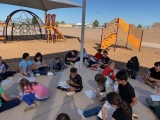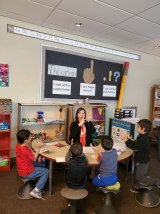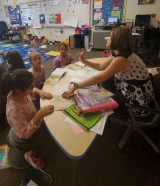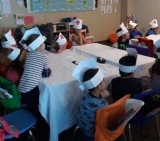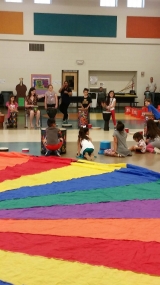-
Category 3
Selected in 2019
-
Grades: k - 5
School Setting: urban
Town Population: 31,701
Student Enrollment: 498
Student Demographics:
Black/African American: 6%
Teacher/Student Ratio: 1:19.9
White/Caucasian: 35%
Hispanic: 48%
Hawaiian/Pacific Islander: 1%
Asian: 3%
Native American: 1%
Other: 6%
% Reduced Lunch: 81%
% ELL Learners: 7%
Founded: 2015 -
PRINCIPAL:
Kaye Crecelius -
CONTACT:
400 S. Washington Ave
Alamogordo, NM 88310
575-812-5750
KAYE.CRECELIUS@ALAMOGORDOSCHOOLS.ORG
Desert Star Elementary School
Alamogordo, NM
Our philosophy of school change begins in building a positive culture for learning and relationships.
- Describe specific programs in place to ensure that families are involved in the success of your school and students.
- Desert Star Elementary School has numerous opportunities for parents and families to be involved in the success in our school and students. We have numerous nights that provide opportunities for families to learn strategies for working with their children at home. For example, on both Literacy and Math Nights, all grade levels have booths set up with activities geared to help students with their math fact fluency, math strategies, reading fluency and/or comprehension. We host a day in March we call Read Across Desert Star in which parents and community members are invited to come in and read to all of our classes during the school day to support literacy. These nights nurture positive relationships with our families and strengthen their understanding of their children’s education.
- Describe the most successful activity your school has initiated to strengthen ties to your community.
- For the past two years, Desert Star Elementary School hosted a Community Fair together with our Literacy Night, which historically has had the biggest turnout of all of our family events. The reasoning behind combining these two events was to be able to spotlight some of the many resources that Alamogordo had to offer that parents might not have known about. We were able to bring in many different agencies and organizations that offered families support and assistance in times of need and some resources that families may just not have known about. Many of our families remarked that this was a pleasant way to find out about the many resources in Alamogordo and hoped that we would continue the practice.
- Describe your philosophy of school change or improvement.
- Our philosophy of school change begins in building a positive culture for learning and building relationships that are the foundation for our Culture of Belief. Teachers need to provide all students with a learning experience that will result in significant growth and achievement in all students. With a Culture of Belief, we make no excuses for students with high-needs, we push them harder because they have further to go to close those gaps! Our positive relationships and belief in them make it possible for students to take risks and believe that they have the ability to rise to those high expectations.
- What are your school’s top two goals for the next year?
- One of our school’s top two goals for the next year is to become a model campus that teachers within the district and from outside the district come to see exemplary teaching and learning. While there are examples of excellence every day, we have not grown to the point of excellence in every classroom, every minute, of every day. The second goal for the next year is to ensure that every student in our school is growing more than one year in reading and mathematics in one school year, regardless of where they started the year.
- What is the single most important factor in the success of your school that others could replicate?
- The single most important factor in the success of our school that others could replicate is the improvement of our school culture. Building our Culture of Belief took finding teachers that did not only proclaim the belief that all students could learn. The individuals that truly make Desert Star magical demonstrate their belief in their students every minute of every day. Some of these teachers begged to test their students who received special education services last year because they knew their relationships would make the difference to their students in those testing rooms! Our Culture of Belief holds ALL students to the same high expectations and all of our students put forth the effort because they feel safe to take those risks because someone believes in them. Before you can succeed, you need to build a positive culture for learning with a staff that believes that ALL students can achieve excellence!
- Describe the program or initiative that has had the greatest positive effect on student achievement, including closing achievement or opportunity gaps, if applicable.
- The initiative that has had the greatest positive effect on student achievement thus far is our commitment to improving our school culture and creating our current Culture of Belief. We knew that before we could begin to improve student achievement, we needed to improve the culture, build relationships, and continue to raise our expectations for all students. As we identified gaps in learning, both in our students and in our teachers, we had to figure out a way to close those gaps while continuing to push forward. For teachers, that took the form of professional development, observation and feedback sessions, and coaching. For students, that looked like scheduled Walk-to-Interventions, before and after school tutoring, peer mentoring, and support from home. Another significant piece of our Culture of Belief is that regardless of socio-economic status, identified ability or disability, our belief and high expectations for learning extends to ALL students.
- Explain how ESEA federal funds are used to support your improvement efforts.
- The funds Desert Star Elementary School receives in ESEA federal funds ensure that our highest-needs students have necessary tools that they need for us to close the achievement gap. For example, for our lowest-performing students that need additional support, we were able to purchase additional leveled readers for teachers to use during Walk-to-Interventions and Guided Reading. Additionally, we paid for software licenses for an online program for our lowest-performing 25% to work on during their morning intervention time when they are not working in a small group or one-on-one with a teacher. ESEA funds have also enabled us to provide our teachers with ongoing high-quality professional development to support the learning of our students.
- Describe how data is used to improve student achievement and inform decision making.
- To ensure that we are consistently moving on the right trajectory to improve student achievement, we carefully dissect our academic data in our school-wide PLCs, using the data gained from our assessments to drive future instruction, create new Walk-to-Intervention groups, and determine what concepts need an entire reteach. Our PBIS team collects, analyzes, and presents our behavior data every four weeks. This team’s objective is to look for trends in systems that may need consideration, trends with particular students, and even trends with particular teachers. The team then creates a goal to reduce the highest infraction of the month and anyone who earned three or fewer office referrals for that same office referral is able to celebrate our successes and improvements each month with a party of their choice. In the two years that we have been using these systems, we have never missed our goal!
- Describe your school culture and explain changes you’ve taken to improve it.
- Desert Star Elementary School has recently been described in an outside culture audit as having a “positive feel” that was likened to “being wrapped in a hug” when you enter the building. However, this was not always the case, and it took finding a staff of individuals who shared in the “Culture of Belief” at Desert Star, the belief in every student’s potential to learn and to achieve excellence. Therefore, we knew that we must provide every student with the tools that he or she need to succeed. We began changing the culture at Desert Star by consistently teaching Boys Town social skills in our classrooms every week. Then we brought in the Ron Clark Academy’s House System, which strengthened our relationships with our students and fostered a sense of belonging in students, staff, and administration. The Culture of Belief that we have carefully nurtured has created a place where students feel safe to take risks and they now share the belief that they can achieve excellence.
Stats
-
Category 3
Selected in 2019
-
Grades: k - 5
School Setting: urban
Town Population: 31,701
Student Enrollment: 498
Student Demographics:
Black/African American: 6%
Teacher/Student Ratio: 1:19.9
White/Caucasian: 35%
Hispanic: 48%
Hawaiian/Pacific Islander: 1%
Asian: 3%
Native American: 1%
Other: 6%
% Reduced Lunch: 81%
% ELL Learners: 7%
Founded: 2015 -
PRINCIPAL:
Kaye Crecelius -
CONTACT:
400 S. Washington Ave
Alamogordo, NM 88310
575-812-5750
KAYE.CRECELIUS@ALAMOGORDOSCHOOLS.ORG



